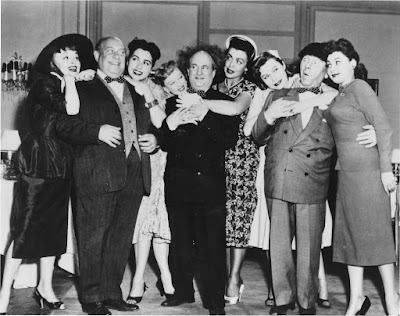 |
| French film poster for the 1966 film version of Batman. |
 |
| From L to R: Catwoman (Lee Meriwhether), The Riddler (Frank Gorshin), The Penguin (Burgess Meredith) and The Joker (Cesar Romero). |

 |
| French film poster for the 1966 film version of Batman. |
 |
| From L to R: Catwoman (Lee Meriwhether), The Riddler (Frank Gorshin), The Penguin (Burgess Meredith) and The Joker (Cesar Romero). |
Posted by secretbasementlab at 12:16 PM 3 comments
Labels: adam west, Batman, mid-week movie break, movies
 |
| Screen grab showcasing some of the oddball club interiors seen in the film. |
 |
| Akira Kobayashi 45 on Colombia |
 |
| The Black Tight Killers in a masked go-go dance frenzy |
 |
| Note the Goldfinger-esque gold-painted dancers. This is a plot point in how the crooks intend to do away with Yuriko. |
 |
| Chieko Matsubara 45 for Colombia Records. |
 |
| A page from issue 18 of The Monster Times, spotlighting TMOPB. |
 |
| The opening shot to the Flipper episode "Flipper's Monster". |
 |
| Jeanne Carmen in a publicity still from The Three Stooges short A Merry Mix-Up. Carmen is third from the left, cuddling up to Joe Besser. |
 The picture was produced by Jack Kevan and production partner Irvin Berwick, a one-time dialog editor for Columbia who had worked with William Castle and Jack Arnold, so he was already entrenched in the ways of the low budget sci-fi/horror/monster movie. Tired of working in obscurity in largely thankless and uncredited roles for the studios, Kevan and Berwick decided to try their hand at becoming independent producers, hence Vanwick Productions. The picture was made for around $29,000 with a number of favors and at-cost help being utilized from Kevan’s old connections at Universal. To my knowledge the only other picture Vanwick Productions ever had a hand in producing is a seedy 1966 drama called The Street Is My Beat, filmed in Texas. Kevan and Berwick did work together again however on pictures like Crown International’s The 7th Commandment (1961).
The picture was produced by Jack Kevan and production partner Irvin Berwick, a one-time dialog editor for Columbia who had worked with William Castle and Jack Arnold, so he was already entrenched in the ways of the low budget sci-fi/horror/monster movie. Tired of working in obscurity in largely thankless and uncredited roles for the studios, Kevan and Berwick decided to try their hand at becoming independent producers, hence Vanwick Productions. The picture was made for around $29,000 with a number of favors and at-cost help being utilized from Kevan’s old connections at Universal. To my knowledge the only other picture Vanwick Productions ever had a hand in producing is a seedy 1966 drama called The Street Is My Beat, filmed in Texas. Kevan and Berwick did work together again however on pictures like Crown International’s The 7th Commandment (1961). |
| Don Sullivan on his book The Perfect Look: Don Sullivan's Hair Care Secrets |
 |
| Honolulu Star Bulletin article highlighting the career of Jack Kevan. |
 |
| Packaging of the Super 8 home movie version of The Monster of Piedras Blancas. |
Posted by secretbasementlab at 8:57 AM 1 comments
Labels: film, mid-week movie break, monster movies, Monsters, movies
 |
| Margaret Hamilton as witch Aunt Huddy in Comin' Round The Mountain |
 |
| Poster for a double bill of Comin' Round The Mountain paired with the 1948 Marjorie Main, Percy Kilbride (not as Ma & Pa Kettle) film Feudin', Fussin' and A-Fightin'. |
Posted by secretbasementlab at 12:58 AM 1 comments
Labels: Comedy, film, mid-week movie break, movies
Freddy Cannon! (From Village Of The Giants, 1965).
Posted by Greg G at 2:30 PM 0 comments
Posted by Greg G at 11:54 AM 1 comments
Labels: Greg, Jazz, Jet, Louis Armstrong, movies, New Orleans
Posted by Greg G at 2:28 PM 0 comments
Labels: 1966, Greg, movies, Radio, Russ Meyer
(Sorry, don't know why the thumbnail's not displaying, but the video does work and is well worth your time!)
As the good folks at PCL LinkDump noted, this clip is "From the 1966 movie STING OF DEATH, the greatest movie ever made featuring a half man, half jellyfish villain. If you enjoy close-up shots of girls butts in tight pants, then this movie is for you!" And, yes, that's Neil Sedaka doing the singing.
You should really click on over to their site, where they've also fixed us up with some fantastic screen captures. Tip of the cap to Thom Tex Edwards for bringing this to my attention.
Posted by Greg G at 2:50 PM 3 comments
Labels: bikinis, Greg, movies, surfer girls

Here's a screen capture from Billy Wilder's superb 1944 film noir, Double Indemnity. Thanks to Debbie, I'm now helplessly addicted to the What Was There site, which will let you superimpose old photos on top of newer views -and- dissolve them back and forth, using the plus and minus keys. I'll try not to go too nuts with this trick here on Ichiban, but we'll see.
This is Quebec Drive at La Punta Drive, up in the Hollywood Hills. Go see what it looks like now. I learned about this (and yesterday's Sunset Strip film clip) via a Facebook group called Vintage Los Angeles, which I very highly recommend you check out.
Posted by Greg G at 1:38 PM 1 comments
Labels: Greg, Los Angeles, movies, photography
Posted by Debbie D at 6:29 PM 2 comments
Labels: Debbie D, movies, Russ Meyer
